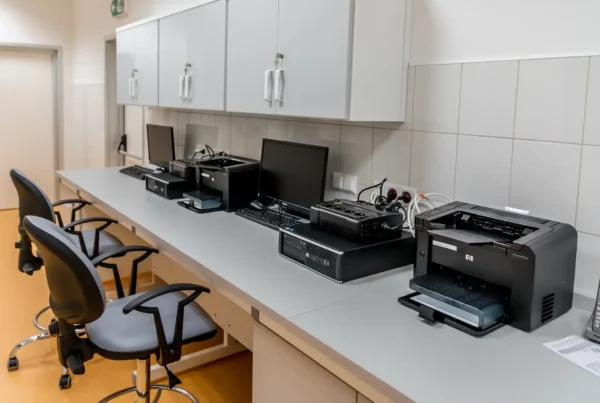There’s no doubt that businesses are having to deal with increasingly complex IT environments. From integrating cloud solutions to managing cybersecurity threats, the demand for a comprehensive approach to IT has never been higher.
A holistic IT strategy ensures that every component of your technology infrastructure works together. As 2025 unfolds, businesses that embrace a unified IT strategy will have a real edge over their competitors.
In this blog we’ll take a look at why fragmented IT systems are holding businesses back, the core components of a holistic IT strategy, and how this approach can future-proof your business.
The Challenges of Fragmented IT Systems
Many businesses operate with a patchwork of disconnected IT solutions. While this approach might seem to save money, or be convenient initially, it often leads to significant challenges:
Inefficiency
Fragmented IT systems create silos that disrupt workflows and duplicate efforts. Employees might waste time switching between tools or searching for data scattered across different platforms.
Example: A sales team using one CRM system while customer support uses a different, incompatible platform can result in miscommunication and missed opportunities.
Security Risks
When IT systems aren’t integrated, gaps emerge — and cybercriminals are quick to take advantage of them. Without a unified security strategy, businesses risk inconsistent protection, leaving sensitive data vulnerable.
Example: A company using separate systems for customer data and email might have MFA on one but not the other. Hackers could exploit the less secure system to access sensitive customer data, leading to compliance breaches and reputational harm.
Scalability Issues
Fragmented IT infrastructures struggle to adapt to growth or change. Adding new tools or scaling existing ones becomes cumbersome when systems don’t communicate well. Imagine trying to integrate a new e-commerce platform with an outdated inventory management system — the result is often costly delays and frustrated customers.
Example: A retail business relying on disconnected inventory, sales, and customer data platforms struggled to meet demand during a holiday sales surge. The lack of integration led to stockouts, delayed shipments, and customer dissatisfaction.
The Core Components of a Holistic IT Strategy
The goal of a holistic IT strategy is to unify all aspects of your technology infrastructure. Here are the five key components:
- Unified Communication Systems – Collaboration tools like Unified Communications as a Service (UCaaS) bring together messaging, video conferencing, and voice calls on a single platform. This ensures seamless communication, especially for hybrid teams working across locations.
- Integrated Cloud Services – Cloud solutions are at the heart of modern IT strategies. Integrating cloud storage, applications, and workflows allows for better data accessibility, reduced redundancy, and improved efficiency. For example, integrating Microsoft 365 with your CRM and ERP systems streamlines operations across departments.
- Comprehensive Cybersecurity Frameworks – In 2025, cybersecurity should no longer be an afterthought. A holistic strategy includes end-to-end protection: firewalls, intrusion detection systems, endpoint protection, and employee training. All these elements work together to reduce security risks.
- Centralized IT Management – Centralized platforms allow businesses to monitor and manage all IT assets in one place. With real-time visibility into system performance and potential issues, IT teams can act proactively, minimizing downtime.
- Proactive Maintenance and Monitoring – Preventive IT maintenance saves time and money compared to reactive solutions. Automated monitoring tools can detect and resolve issues before they escalate, ensuring business continuity.

Key Benefits of a Holistic IT Strategy
Investing in a holistic IT strategy has many benefits, from increased efficiency to long-term cost savings. Here are the top advantages:
Improved Productivity
When IT systems work together, employees spend less time troubleshooting and more time focusing on their jobs. Imagine a marketing team able to pull real-time sales data directly into their analytics platform without manual data transfers.
Cost Efficiency
While implementing a holistic IT strategy requires an upfront investment, the long-term savings are significant. Centralized systems reduce redundancies, lower operational costs, and eliminate the need for multiple vendors.
Enhanced Security
A unified cybersecurity approach closes gaps and ensures consistent protection across all platforms. For example, implementing a single identity and access management (IAM) system simplifies user authentication while strengthening security.
Scalability and Future-Proofing
Holistic IT strategies are designed to grow with your business. Whether you’re expanding into new markets, adopting AI tools, or integrating IoT devices, a unified IT infrastructure can adapt to changing needs.
Why 2025 Is the Year to Act
The need for a holistic IT strategy isn’t new, but 2025 presents unique challenges and opportunities that make it the perfect time to act:
Technological Trends
Emerging technologies like AI, 5G, and IoT are reshaping industries. To leverage these advancements, businesses need integrated IT systems capable of handling increased complexity and data volumes.
Competitive Edge
Businesses that adopt holistic strategies are outperforming their competition. With improved efficiency, better security, and faster decision-making, they gain a clear advantage.
Regulatory Pressures
Governments and industries are introducing stricter compliance requirements. A fragmented IT setup makes meeting these standards difficult and exposes businesses to penalties.
Economic Factors
With global economic uncertainty, businesses are under pressure to maximize ROI. Holistic IT strategies offer cost-efficient solutions that deliver long-term value.

Steps to Implement a Holistic IT Strategy
Transitioning to a holistic IT strategy might seem daunting, but a structured approach makes it manageable. Here are five key steps:
- Assess Current IT Landscape – Start by conducting a thorough audit of your existing systems. Identify inefficiencies, redundancies, and vulnerabilities.
- Define Goals and KPIs – Establish clear objectives for your IT strategy. For example, reducing downtime by 50% or improving employee productivity by 30%.
- Partner with Experts – Managed IT Services providers bring expertise in integration, system management, and cybersecurity. Partnering with a trusted provider will make for a smooth transition.
- Invest in Scalable Solutions – Prioritize tools and platforms that can grow with your business. For instance, adopting cloud-based ERP systems provides flexibility and scalability.
- Train Your Workforce
Even the best IT systems are ineffective if employees don’t know how to use them. Provide comprehensive training to ensure smooth adoption.
The Role of Managed IT Services in Holistic IT Strategies
Managed IT Services providers can play an important role in implementing and maintaining holistic IT strategies. Here’s how they can help:
- Expert Integration: Managed IT providers specialize in unifying disparate systems, ensuring seamless communication between platforms.
- 24/7 Monitoring and Support: Continuous monitoring identifies and resolves issues before they impact your business.
- Tailored Solutions: Providers can design IT strategies tailored to your needs, whether you’re a small business or an enterprise.
Future Outlook: The Evolving Role of IT in Business
As technology evolves, so will the demands on IT strategies. Here’s what the future holds:
- AI and Machine Learning: These tools will drive automation, predictive analytics, and smarter decision-making.
- More Robust Cloud Ecosystems: Businesses will rely even more on cloud platforms for scalability and cost efficiency.
- Enhanced Collaboration Tools: With hybrid and remote work here to stay, tools like virtual reality meeting spaces will gain prominence.
To stay ahead, businesses must continuously evaluate and adapt their IT strategies.
Why It Matters
Taking a piecemeal approach to IT leaves businesses vulnerable to cyberattacks, compliance issues, and productivity challenges. By adopting a holistic IT strategy, businesses can close security gaps, improve their productivity, and protect their reputation.
Investing in an integrated and secure IT environment isn’t just about staying ahead—it’s about ensuring your business remains resilient and competitive in a technology-driven era of constant change.







